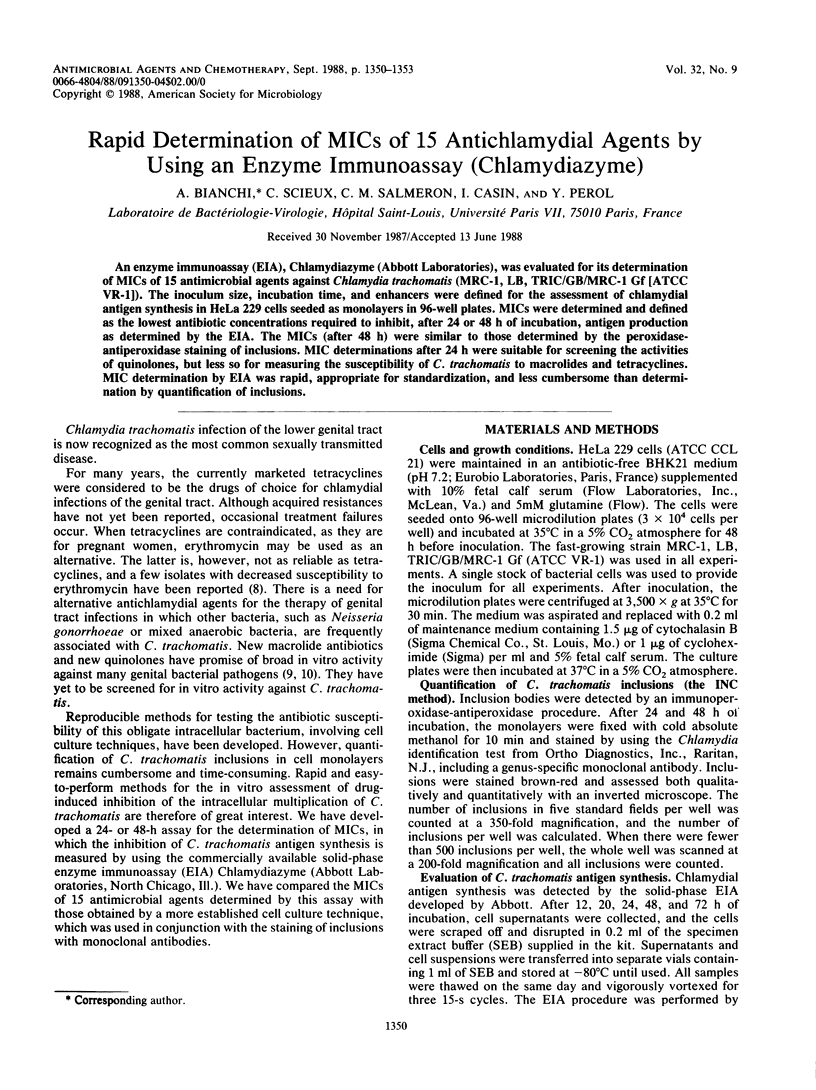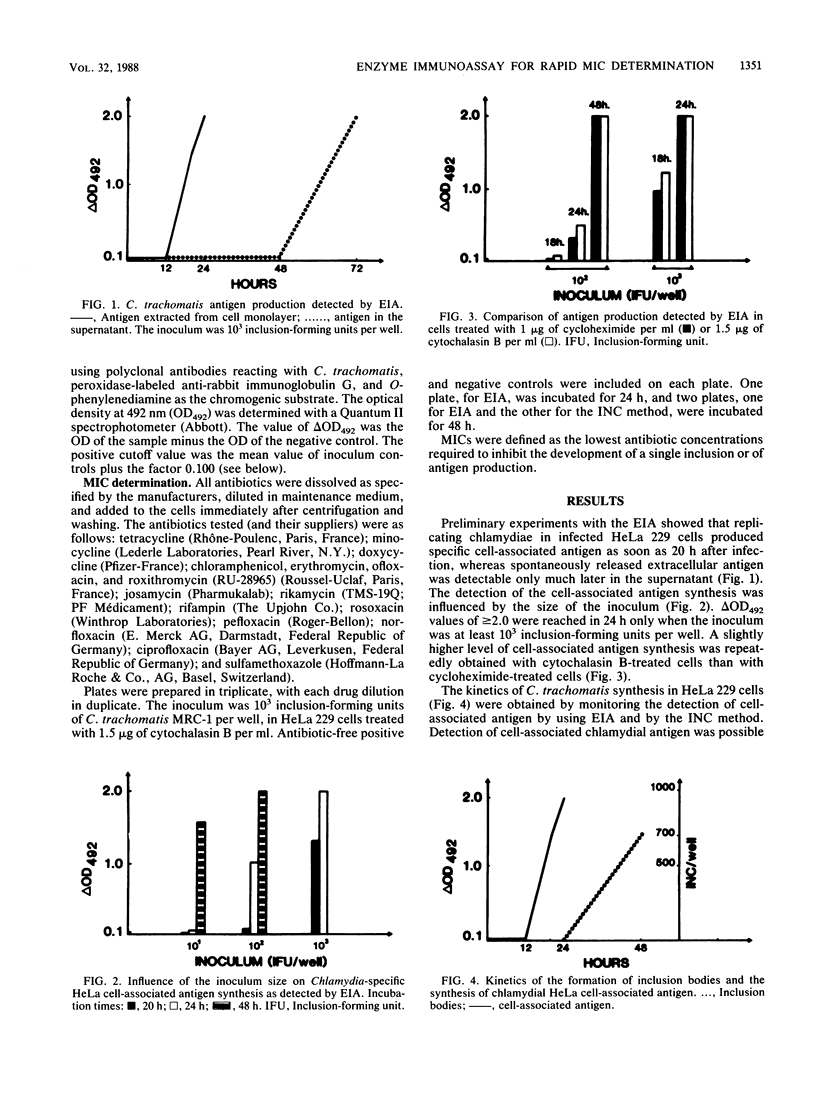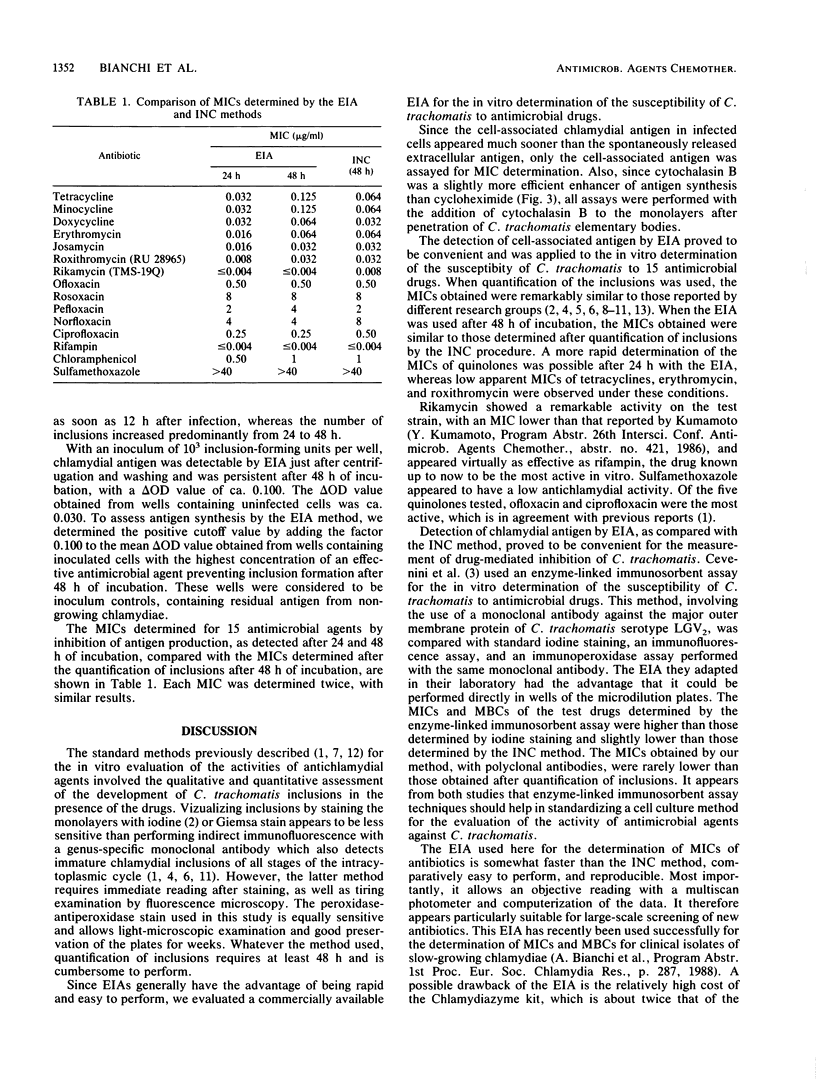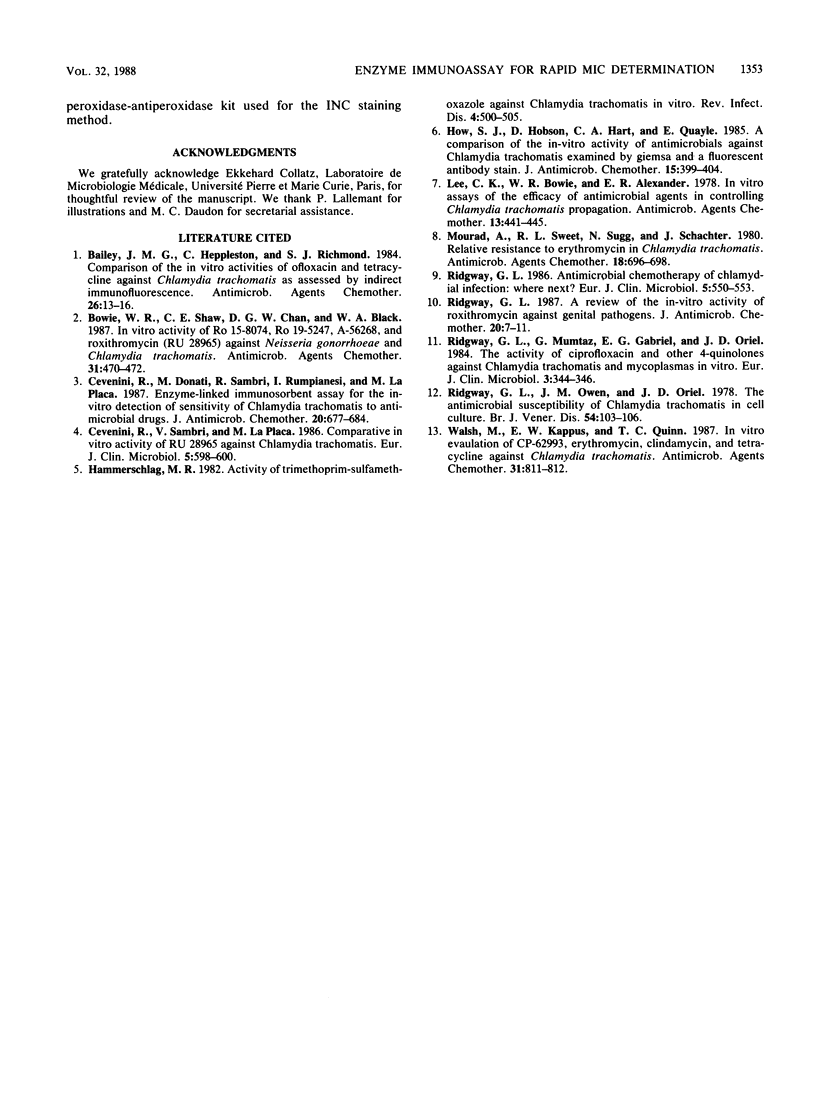Abstract
An enzyme immunoassay (EIA), Chlamydiazyme (Abbott Laboratories), was evaluated for its determination of MICs of 15 antimicrobial agents against Chlamydia trachomatis (MRC-1, LB, TRIC/GB/MRC-1 Gf [ATCC VR-1]). The inoculum size, incubation time, and enhancers were defined for the assessment of chlamydial antigen synthesis in HeLa 229 cells seeded as monolayers in 96-well plates. MICs were determined and defined as the lowest antibiotic concentrations required to inhibit, after 24 or 48 h of incubation, antigen production as determined by the EIA. The MICs (after 48 h) were similar to those determined by the peroxidase-antiperoxidase staining of inclusions. MIC determinations after 24 h were suitable for screening the activities of quinolones, but less so for measuring the susceptibility of C. trachomatis to macrolides and tetracyclines. MIC determination by EIA was rapid, appropriate for standardization, and less cumbersome than determination by quantification of inclusions.
Full text
PDF



Selected References
These references are in PubMed. This may not be the complete list of references from this article.
- Bailey J. M., Heppleston C., Richmond S. J. Comparison of the in vitro activities of ofloxacin and tetracycline against Chlamydia trachomatis as assessed by indirect immunofluorescence. Antimicrob Agents Chemother. 1984 Jul;26(1):13–16. doi: 10.1128/aac.26.1.13. [DOI] [PMC free article] [PubMed] [Google Scholar]
- Bowie W. R., Shaw C. E., Chan D. G., Black W. A. In vitro activity of Ro 15-8074, Ro 19-5247, A-56268, and roxithromycin (RU 28965) against Neisseria gonorrhoeae and Chlamydia trachomatis. Antimicrob Agents Chemother. 1987 Mar;31(3):470–472. doi: 10.1128/aac.31.3.470. [DOI] [PMC free article] [PubMed] [Google Scholar]
- Cevenini R., Donati M., Sambri V., Rumpianesi F., La Placa M. Enzyme-linked immunosorbent assay for the in-vitro detection of sensitivity of Chlamydia trachomatis to antimicrobial drugs. J Antimicrob Chemother. 1987 Nov;20(5):677–684. doi: 10.1093/jac/20.5.677. [DOI] [PubMed] [Google Scholar]
- Cevenini R., Sambri V., La Placa M. Comparative in vitro activity of RU 28965 against Chlamydia trachomatis. Eur J Clin Microbiol. 1986 Oct;5(5):598–600. doi: 10.1007/BF02017714. [DOI] [PubMed] [Google Scholar]
- Hammerschlag M. R. Activity of trimethoprim-sulfamethoxazole against Chlamydia trachomatis in vitro. Rev Infect Dis. 1982 Mar-Apr;4(2):500–505. doi: 10.1093/clinids/4.2.500. [DOI] [PubMed] [Google Scholar]
- How S. J., Hobson D., Hart C. A., Quayle E. A comparison of the in-vitro activity of antimicrobials against Chlamydia trachomatis examined by Giemsa and a fluorescent antibody stain. J Antimicrob Chemother. 1985 Apr;15(4):399–404. doi: 10.1093/jac/15.4.399. [DOI] [PubMed] [Google Scholar]
- Lee C. K., Bowie W. R., Alexander E. R. In vitro assays of the efficacy of antimicrobial agents in controlling Chlamydia trachomatis propagation. Antimicrob Agents Chemother. 1978 Mar;13(3):441–445. doi: 10.1128/aac.13.3.441. [DOI] [PMC free article] [PubMed] [Google Scholar]
- Mourad A., Sweet R. L., Sugg N., Schachter J. Relative resistance to erythromycin in Chlamydia trachomatis. Antimicrob Agents Chemother. 1980 Nov;18(5):696–698. doi: 10.1128/aac.18.5.696. [DOI] [PMC free article] [PubMed] [Google Scholar]
- Ridgway G. L. A review of the in-vitro activity of roxithromycin against genital pathogens. J Antimicrob Chemother. 1987 Nov;20 (Suppl B):7–11. doi: 10.1093/jac/20.suppl_b.7. [DOI] [PubMed] [Google Scholar]
- Ridgway G. L. Antimicrobial chemotherapy of chlamydial infection: where next? Eur J Clin Microbiol. 1986 Oct;5(5):550–553. doi: 10.1007/BF02017703. [DOI] [PubMed] [Google Scholar]
- Ridgway G. L., Mumtaz G., Gabriel F. G., Oriel J. D. The activity of ciprofloxacin and other 4-quinolones against Chlamydia trachomatis and Mycoplasmas in vitro. Eur J Clin Microbiol. 1984 Aug;3(4):344–346. doi: 10.1007/BF01977491. [DOI] [PubMed] [Google Scholar]
- Ridgway G. L., Owen J. M., Oriel J. D. The antimicrobial susceptibility of Chlamydia trachomatis in cell culture. Br J Vener Dis. 1978 Apr;54(2):103–106. doi: 10.1136/sti.54.2.103. [DOI] [PMC free article] [PubMed] [Google Scholar]
- Walsh M., Kappus E. W., Quinn T. C. In vitro evaluation of CP-62,993, erythromycin, clindamycin, and tetracycline against Chlamydia trachomatis. Antimicrob Agents Chemother. 1987 May;31(5):811–812. doi: 10.1128/aac.31.5.811. [DOI] [PMC free article] [PubMed] [Google Scholar]


